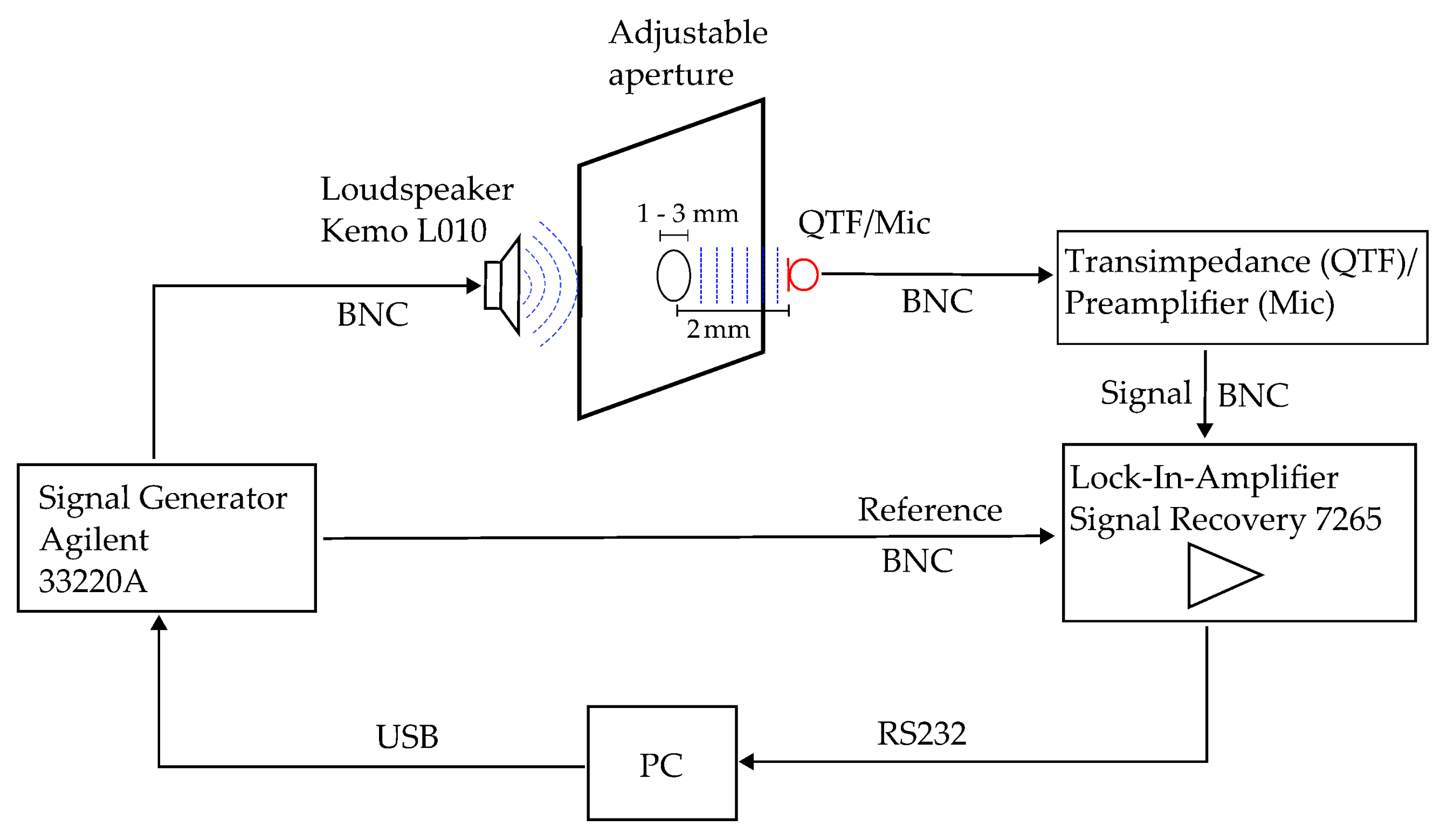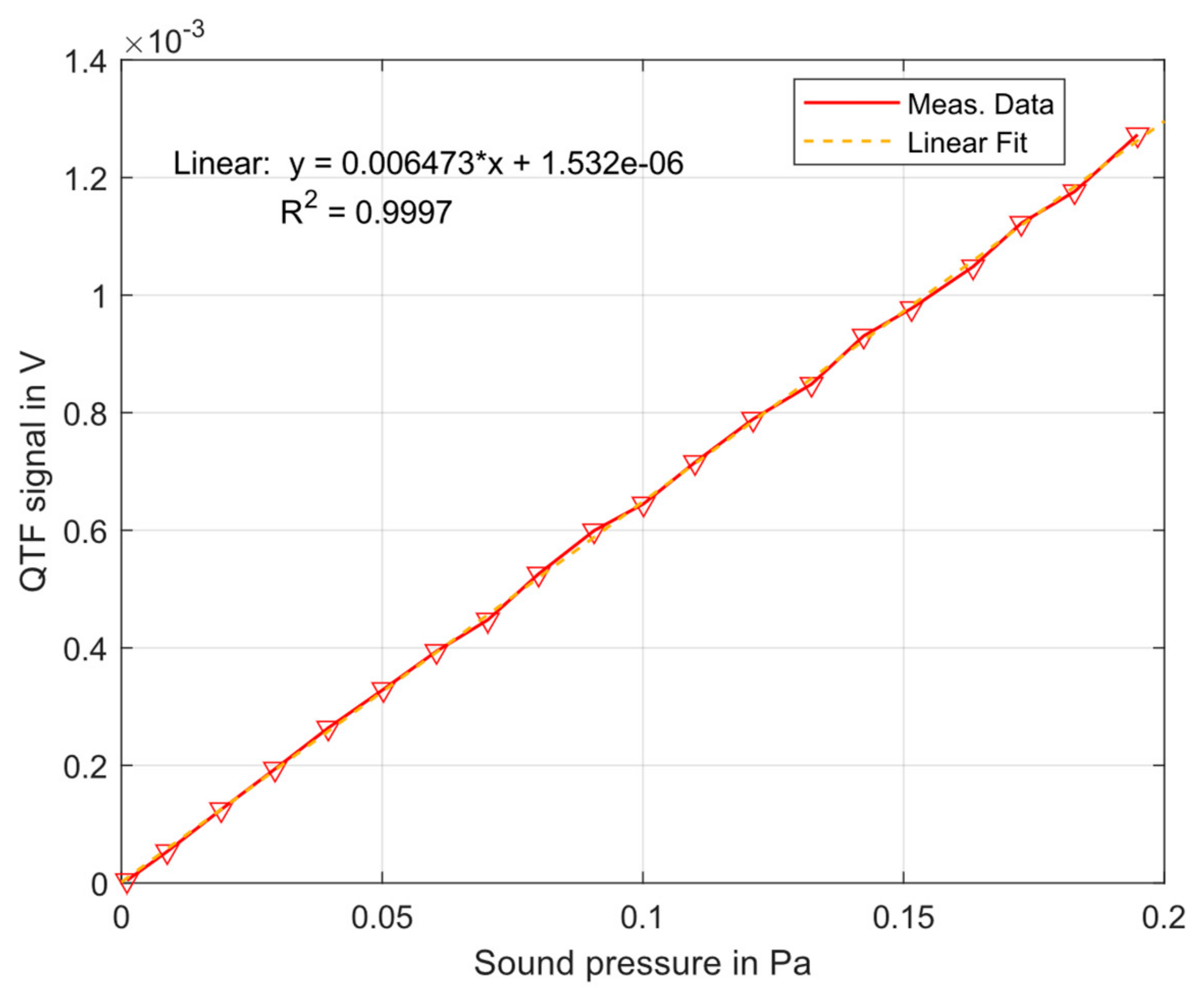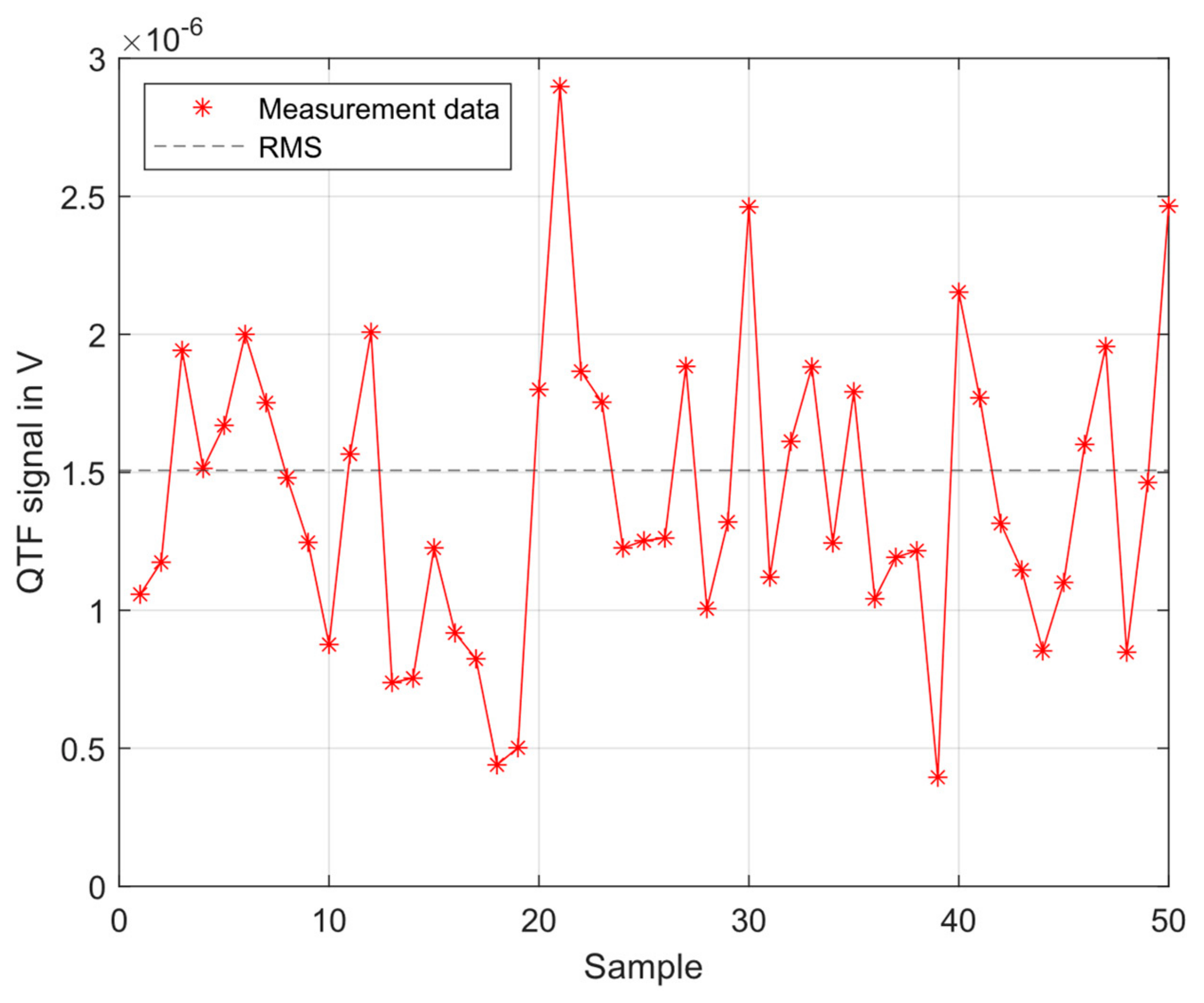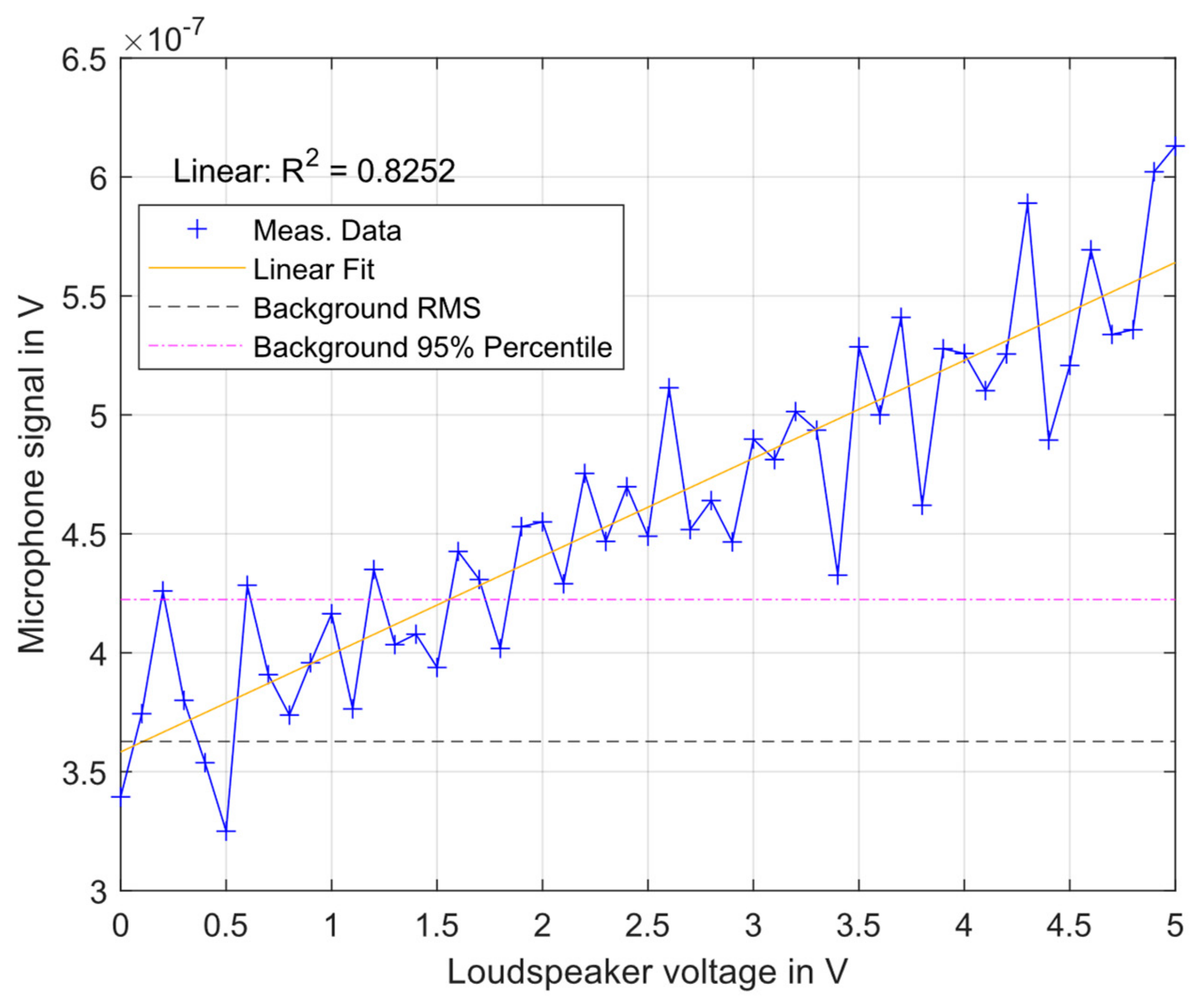Calibration of a Quartz Tuning Fork as a Sound Detector
Abstract
1. Introduction
2. Materials and Methods
2.1. Experimental Setup
2.2. Methods
3. Results
3.1. Microphone Sensitivity

3.2. QTF Sensitivity
3.3. Microphone and Qtf Background Noise
3.4. Microphone and QTF Detection Limit
4. Discussion
Author Contributions
Funding
Institutional Review Board Statement
Informed Consent Statement
Data Availability Statement
Acknowledgments
Conflicts of Interest
References
- Lombardi, M.A. The evolution of time measurement, Part 2: Quartz clocks [Recalibration]. IEEE Instrum. Meas. Mag. 2011, 14, 41–48. [Google Scholar] [CrossRef]
- Bloch, M.; Mancini, O.; McClelland, T. Performance of rubidium and quartz clocks in space. In Proceedings of the 2002 IEEE International Frequency Control Symposium and PDA Exhibition (Cat. No. 02CH37234), New Orleans, LA, USA, 31 May 2002; IEEE: Piscataway, NJ, USA, 2002. [Google Scholar]
- Milde, T.; Hoppe, M.; Tatenguem, H.; Rohling, H.; Schmidtmann, S.; Honsberg, M.; Schade, W.; Sacher, J. QEPAS sensor in a butterfly package and its application. Appl. Opt. 2021, 60, C55–C59. [Google Scholar] [CrossRef] [PubMed]
- De Carlo, M.; Menduni, G.; Sampaolo, A.; De Leonardis, F.; Spagnolo, V.; Passaro, V.M. Modeling and design of a semi-integrated QEPAS sensor. J. Light. Technol. 2020, 39, 646–653. [Google Scholar] [CrossRef]
- Liberatore, N.; Viola, R.; Mengali, S.; Masini, L.; Zardi, F.; Elmi, I.; Zampolli, S. Compact GC-QEPAS for On-Site Analysis of Chemical Threats. Sensors 2022, 23, 270. [Google Scholar] [CrossRef] [PubMed]
- Li, B.; Menduni, G.; Giglio, M.; Patimisco, P.; Sampaolo, A.; Zifarelli, A.; Wu, H.; Wei, T.; Spagnolo, V.; Dong, L. Quartz-enhanced photoacoustic spectroscopy (QEPAS) and Beat Frequency-QEPAS techniques for air pollutants detection: A comparison in terms of sensitivity and acquisition time. Photoacoustics 2023, 31, 100479. [Google Scholar] [CrossRef] [PubMed]
- Liu, Y.; Lin, H.; Montano, B.A.Z.; Zhu, W.; Zhong, Y.; Kan, R.; Yuan, B.; Yu, J.; Shao, M.; Zheng, H. Integrated near-infrared QEPAS sensor based on a 28 kHz quartz tuning fork for online monitoring of CO2 in the greenhouse. Photoacoustics 2022, 25, 100332. [Google Scholar] [PubMed]
- Angstenberger, S.; Floess, M.; Schmid, L.; Ruchka, P.; Steinle, T.; Giessen, H. Coherent control in quartz-enhanced photoacoustics: Fingerprinting a trace gas at ppm-level within seconds. Optica 2025, 12, 1–4. [Google Scholar]
- Yang, M.; Wang, Z.; Sun, H.; Hu, M.; Yeung, P.T.; Nie, Q.; Liu, S.; Akikusa, N.; Ren, W. Highly sensitive QEPAS sensor for sub-ppb N2O detection using a compact butterfly-packaged quantum cascade laser. Appl. Phys. B Laser Opt. 2024, 130, 6. [Google Scholar] [CrossRef]
- Liang, T.; Qiao, S.; Chen, Y.; He, Y.; Ma, Y. High-sensitivity methane detection based on QEPAS and H-QEPAS technologies combined with a self-designed 8.7 kHz quartz tuning fork. Photoacoustics 2024, 36, 100592. [Google Scholar] [CrossRef] [PubMed]
- Sampaolo, A.; Menduni, G.; Patimisco, P.; Giglio, M.; Passaro, V.M.; Dong, L.; Wu, H.; Tittel, F.K.; Spagnolo, V. Quartz-enhanced photoacoustic spectroscopy for hydrocarbon trace gas detection and petroleum exploration. Fuel 2020, 277, 118118. [Google Scholar] [CrossRef]
- Hussain, D.; Zhang, H.; Song, J.; Yongbing, W.; Meng, X.; Xinjian, F.; Xie, H. Amplitude calibration of quartz tuning fork (QTF) force sensor with an atomic force microscope. In Proceedings of the 2017 IEEE 17th International Conference on Nanotechnology (IEEE-NANO), Pittsburgh, PA, USA, 25–28 July 2017; IEEE: Piscataway, NJ, USA, 2017. [Google Scholar]
- Dedeoglu, A.; Karadas, N.; Unal, M.A.; Kocum, I.C.; Serdaroglu, D.C.; Ozkan, S.A. Calibration of Quartz Tuning Fork transducer by coulometry for mass sensitive sensor studies. J. Electroanal. Chem. 2019, 834, 8–16. [Google Scholar]
- Falkhofen, J.; Bahr, M.-S.; Baumann, B.; Wolff, M. Quartz enhanced photoacoustic spectroscopy on solid samples. Sensors 2024, 24, 4085. [Google Scholar] [CrossRef] [PubMed]
- Patimisco, P.; Sampaolo, A.; Zheng, H.; Dong, L.; Tittel, F.K.; Spagnolo, V. Quartz–enhanced photoacoustic spectrophones exploiting custom tuning forks: A review. Adv. Phys. X 2017, 2, 169–187. [Google Scholar]
- GRAS Sound & Vibration. In Instruction Manual 42AG Multifunction Calibrator; GRAS Sound & Vibration: Holte, Denmark, 2017; Available online: google.com/url?sa=t&rct=j&q=&esrc=s&source=web&cd=&ved=2ahUKEwigmbLvlqWMAxW2cfEDHedhJFQQFnoECBsQAQ&url=https%3A%2F%2Fwww.grasacoustics.com%2Ffileadmin-gras%2FProducts%2FFiles%2Fmanual_42AG_LI0196.pdf&usg=AOvVaw2zSv6vyAbbX1oodBTclSgp&opi=89978449 (accessed on 5 February 2025).
- DIN 32645; Chemische Analytik–Nachweis-, Erfassungs-und Bestimmungsgrenze unter Wiederholbedingungen, Verfahren, Auswertung. DIN Media: Berlin, Germany, 2008.
- Falkhofen, J.; Wolff, M. Near-ultrasonic transfer function and SNR of differential MEMS microphones suitable for photoacoustics. Sensors 2023, 23, 2774. [Google Scholar] [CrossRef] [PubMed]
- Wu, H.; Dong, L.; Zheng, H.; Yu, Y.; Ma, W.; Zhang, L.; Yin, W.; Xiao, L.; Jia, S.; Tittel, F.K. Beat frequency quartz-enhanced photoacoustic spectroscopy for fast and calibration-free continuous trace-gas monitoring. Nat. Commun. Nat. Commun. 2017, 8, 15331. [Google Scholar] [CrossRef] [PubMed]
- Winkowski, M.; Stacewicz, T. Low noise, open-source QEPAS system with instrumentation amplifier. Sci. Rep. 2019, 9, 1838. [Google Scholar]
- Wieczorek, P.Z.; Starecki, T.; Tittel, F.K. Improving the signal to noise ratio of QTF preamplifiers dedicated for QEPAS applications. Appl. Sci. 2020, 10, 4105. [Google Scholar] [CrossRef]







| Parameter | Unit | Microphone | QTF |
|---|---|---|---|
| Bandwidth | Hz | ) | 4.72 (FWHM) |
| Dimension | mm | 53 × 7 (incl. preamplifier) | 6 × 3 (length × width) |
| Price (ca.) | Euro | 2700 | 0.20 |
| mV/Pa | |||
at low level | % | 82.52 | 92.89 |
at high level | % | 100.00 | 99.97 |
| % of RMS | 4.86 | 15.15 | |
| Pa | |||
| SNR at 0.596 mPa | dB | 3.84 | 17.58 |
Disclaimer/Publisher’s Note: The statements, opinions and data contained in all publications are solely those of the individual author(s) and contributor(s) and not of MDPI and/or the editor(s). MDPI and/or the editor(s) disclaim responsibility for any injury to people or property resulting from any ideas, methods, instructions or products referred to in the content. |
© 2025 by the authors. Licensee MDPI, Basel, Switzerland. This article is an open access article distributed under the terms and conditions of the Creative Commons Attribution (CC BY) license (https://creativecommons.org/licenses/by/4.0/).
Share and Cite
Falkhofen, J.; Wolff, M. Calibration of a Quartz Tuning Fork as a Sound Detector. Appl. Sci. 2025, 15, 3655. https://doi.org/10.3390/app15073655
Falkhofen J, Wolff M. Calibration of a Quartz Tuning Fork as a Sound Detector. Applied Sciences. 2025; 15(7):3655. https://doi.org/10.3390/app15073655
Chicago/Turabian StyleFalkhofen, Judith, and Marcus Wolff. 2025. "Calibration of a Quartz Tuning Fork as a Sound Detector" Applied Sciences 15, no. 7: 3655. https://doi.org/10.3390/app15073655
APA StyleFalkhofen, J., & Wolff, M. (2025). Calibration of a Quartz Tuning Fork as a Sound Detector. Applied Sciences, 15(7), 3655. https://doi.org/10.3390/app15073655






